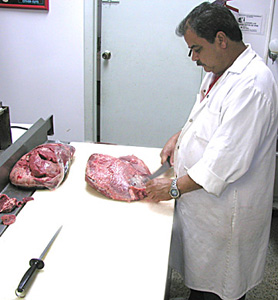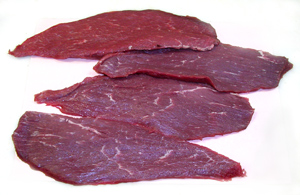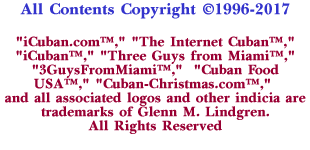
What makes Cuban cuts of beef different? For one thing, Cubans have created many dishes that take advantage of cheaper cuts of meat. That's one of the reasons why Cuban steaks are almost always sliced very thin and either cooked very quickly, or slow cooked with plenty of liquid -- as in bistec rollito.

Make sure you know what grade of meat you are buying. In some parts of the country, it's not unusual to find some butchers selling commercial and utility grades of beef. These grades are NOT recommended for your kitchen.
Select grades (as well as some of the cheaper cuts of beef) may also need some mechanical tenderizing. You can do this at home, or have your butcher run the steaks through a tenderizing machine. If you can, always choose choice or prime beef.
Know Your (Cuban) Cuts of Meat!
A complete guide to the most popular Latin American butcher cuts of beef
However, if you have a Non-Latin butcher shop or shop at a typical American grocery, it is still possible to obtain just about any of these Cuban cuts. (Cuban cows and American cows are exactly alike! OK, the American cows have probably never seen sugar cane, but that is just about the only difference.)
Just bring this guide to your butcher – he or she can cut anything to order.

Bistec de Cañada – top round steak. Because this is a tougher cut, it needs to be sliced very thin and cooked quickly. May need mechanical or manual tenderization. Sometimes called bistec de centro.
Bistec de churrasco de vacio (flap meat churrasco) – is cut from the internal flank plate. Many consider this cut a delicacy with a little more flavor than the standard churrasco.




Bistec de lomo de res – is a rib steak cut from the small end of a rib roast, usually with the bone removed. (See also chuleta and rib eye.)
Bistec de paleta de res -- is a chuck shoulder steak, sliced thin. In case you were wondering, these are usually cut from the neck and shoulders of the cow.
Bistec de palomilla – beef loin sirloin, cut from the top butt, one of the two main muscles that make up the sirloin. Some places cut this from the bottom sirloin, a tougher cut of meat that needs to be run through a tenderizer.
Bistec de pecho sin hueso – is a boneless blade cut chuck steak from the chuck primal of the cow. These are cut from a chuck roast.
Bistec de res – is a bone-in chuck steak.

Bistec de falda posterior – flank steak. (Sometimes just labeled or called falda.) Cows evidently use these flank muscles a lot, resulting in a well exercised muscle that is full of flavor. Always cut cooked falda or flank steak against the grain for a very tender eating experience.





